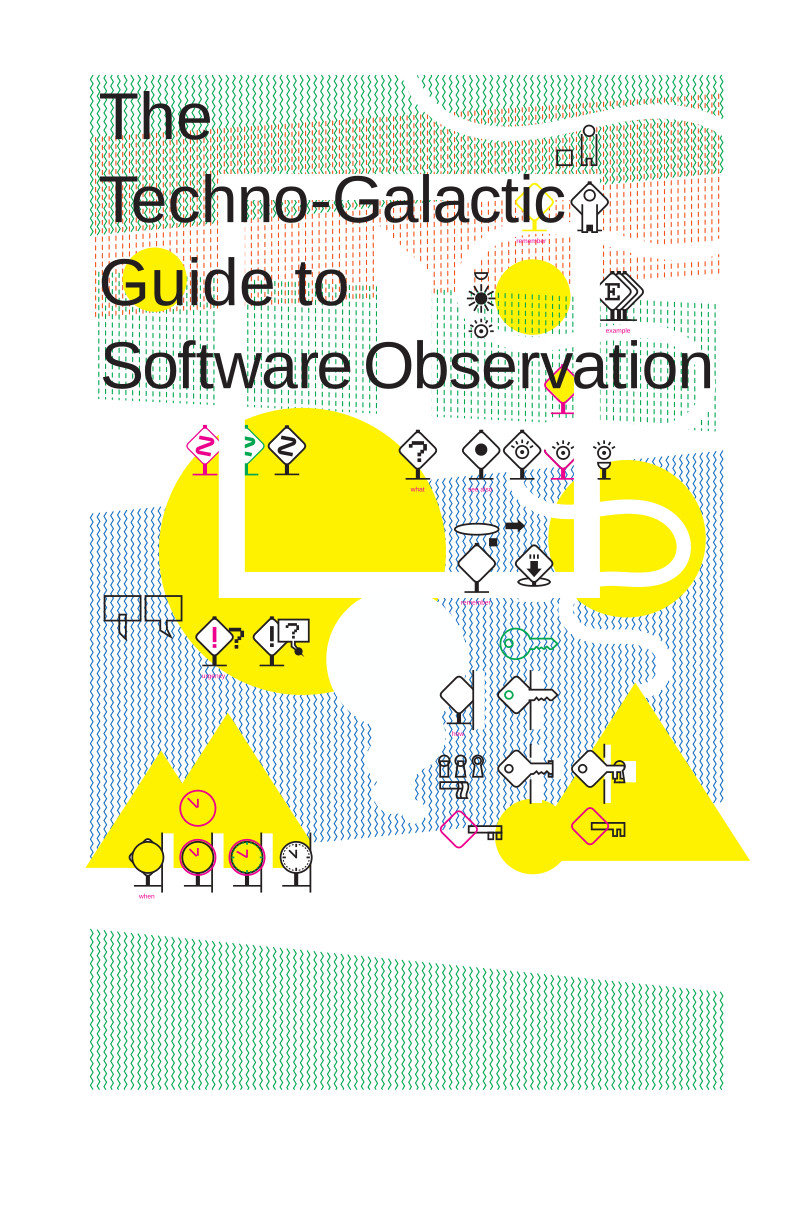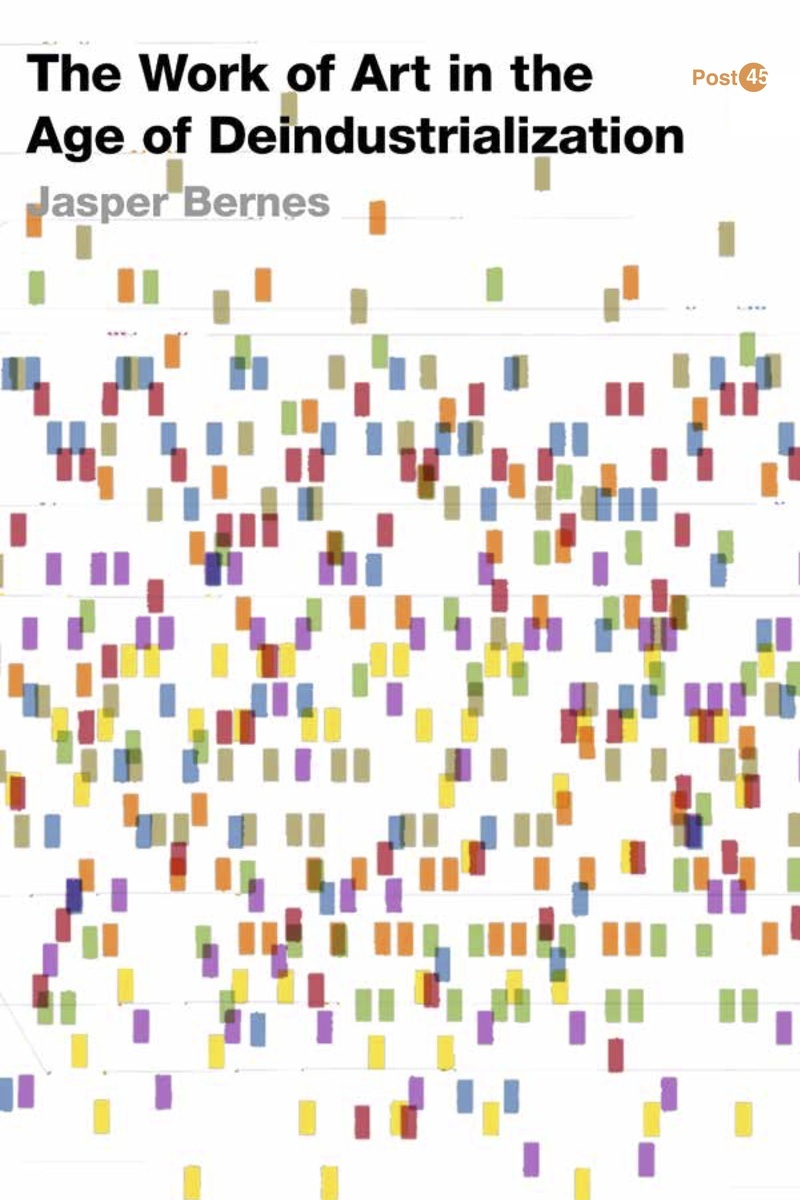The Techno-Galactic Guide to Software Observation (2018)
Filed under book | Tags: · agility, art, code, compilation, design, free software, interface, productivity, software, software studies, time, touch

“This techno-galactic software survival guide was collectively produced as an outcome of the Techno-Galactic Software Observatory (Brussels, 2017). This guide proposes several ways to achieve critical distance from the seemingly endless software systems that surround us. It offers practical and fantastical tools for the tactical (mis)use of software, empowering/enabling users to resist embedded paradigms and assumptions. It is a collection of methods for approaching software, experiencing its myths and realities, its risks and benefits.”
With contributions from Manetta Berends, Željko Blaće, Larisa Blazic, Freyja van den Boom, Anna Carvalho, Loup Cellard, Joana Chicau, Cristina Cochior, Pieter Heremans, Joak aka Joseph Knierzinger, Jogi Hofmüller, Becky Kazansky, Anne Laforet, Ricardo Lafuente, Michaela Lakova, Hans Lammerant, Silvio Lorusso, Mia Melvaer, An Mertens, Lidia Pereira, Donatella Portoghese, Luis Rodil-Fernandez, Natacha Roussel, Andrea di Serego Alighieri, Lonneke van der Velden, Ruben van de Ven, Kym Ward, Wendy Van Wynsberghe, and Peter Westenberg.
Compiled by Carlin Wing, Martino Morandi, Peggy Pierrot, Anita Burato, Christoph Haag, Michael Murtaugh, Femke Snelting, and Seda Gürses
Publisher Constant, Brussels, 2018
Free Art License 1.3
ISBN 9789081145961
244 pages
Publisher
Project folder
Event
PDF, PDF (44 MB)
HTML (different version)
Git
Jasper Bernes: The Work of Art in the Age of Deindustrialization (2017)
Filed under book | Tags: · aesthetics, avant-garde, capitalism, cybernetics, information, labour, literary criticism, marxism, poetry, postindustrial, productivity, taylorism, technology, work

“A novel account of the relationship between postindustrial capitalism and postmodern culture, this book looks at American poetry and art of the last fifty years in light of the massive changes in people’s working lives. Over the last few decades, we have seen the shift from an economy based on the production of goods to one based on the provision of services, the entry of large numbers of women into the workforce, and the emergence of new digital technologies that have transformed the way people work. The Work of Art in the Age of Deindustrialization argues that art and literature not only reflected the transformation of the workplace but anticipated and may have contributed to it as well, providing some of the terms through which resistance to labor was expressed. As firms continue to tout creativity and to reorganize in response to this resistance, they increasingly rely on models of labor that derive from values and ideas found in the experimental poetry and conceptual art of decades past.”
Publisher Stanford University Press, 2017
Post ’45 series
ISBN 9780804796415, 0804796416
viii+231 pages
Reviews: Stevphen Shukaitis (Marx & Philosophy Review of Books, 2017), Julian Murphet (Affirmations, 2017), Vince Carducci (Public Seminar, 2017).
Comment (0)Hausmann, Hidalgo et al.: The Atlas of Economic Complexity: Mapping Paths to Prosperity (2011)
Filed under book | Tags: · complexity, data visualisation, economy, industry, knowledge production, production, productivity

The Atlas of Economic Complexity: Mapping Paths to Prosperity measures the diversity of productive knowledge of 128 countries and demonstrates remarkable predictive value in forecasting how fast countries will grow. Its authors argue that it is 10 times more accurate at predicting growth over a decade than the World Economic Forum’s Global Competitiveness Index. The framework is used to project growth to 2020.
China (1), India (2) and Thailand (3) top the rankings for per capita growth potential followed by Belarus (4), Moldova (5), Zimbabwe (6), Ukraine (7), Bosnia and Herzegovina (8), Panama (9), and Mexico (10). For these countries, the current level of productive knowledge is unusually high for their level of income which should allow them to catch up faster than other nations. Seven Eastern European countries rank in the top 20 in terms of expected growth in income per capita while only two Latin American countries (Panama and Mexico) are in that group.
The Atlas identifies eight Sub-Saharan African countries among the Top Ten for expected GDP growth: Uganda (1), Kenya (2), Tanzania (3), Zimbabwe (4), Madagascar (5), Senegal (6), Malawi (7), and Zambia (10). The other Top Ten nations are India (8) and Guatemala (9). Unfortunately, Sub-Saharan African countries also dominate the bottom 10 countries in terms of expected growth per capita.
Meanwhile, several Eastern European countries rank surprisingly high in their Economic Complexity, which is a gauge to measure their productive knowledge. The Atlas ranks the Czech Republic eighth and Slovenia tenth while Hungary and the Slovak Republic appear in the top 20. Other Top Ten ranked countries in economic complexity include Japan (1), Germany (2), Switzerland (3), Sweden (4), Austria (5), Finland (6), Singapore (7), and the United Kingdom (9).
The United States, at position 13, is not listed among the Top Ten ranking for economic complexity and is ranked 85th for expected GDP growth.
“A country’s competitiveness is driven by the amount of productive knowledge that its people and organizations hold and it is expressed in the variety and complexity of the products it is able to successfully export. Productive knowledge does a remarkable job at explaining why countries are rich or poor and why some catch up and others do not,” says Ricardo Hausmann, report co-author and director of CID.
“In the short run, countries with natural resource wealth can be rich without much productive knowledge and get access to the world’s knowledge through imports. In the long run, however, wells run dry and mines get depleted, and income sooner or later will reflect the productive knowledge of the economy,” says César Hidalgo, report co-author and director of the Macro Connections group at the MIT Media Lab. (from press release)
Authors: Ricardo Hausmann, Cesar A. Hidalgo, Sebastian Bustos, Michele Coscia, Sarah Chung, Juan Jimenez, Alexander Simoes, Muhammed A. Yildirim.
Published in October 2011
A collaboration between Center for International Development at Harvard University and Macro Connections group at the MIT Media Lab.
ISBN 0615546625, 9780615546629
362 pages
Licensed under a Creative Commons Attribution-NonCommercial-NoDerivs 3.0 Unported License.

